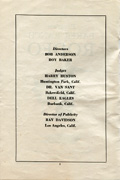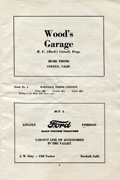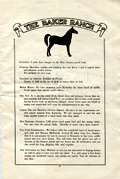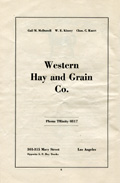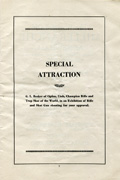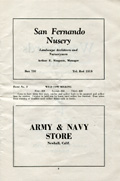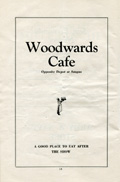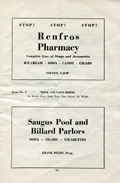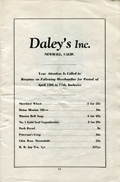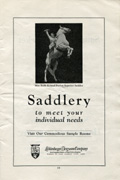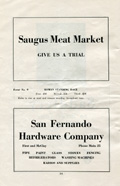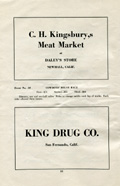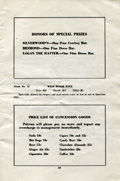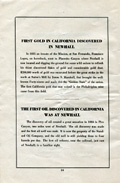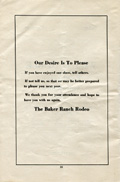|
|
Baker Ranch Rodeo Program, 4-11-1926
Saugus, California

Click image to enlarge
Page 6 Advertisement for Western Hay and Grain Co. of Los Angeles (Gail M. McDowell, W.E. Kinney and Charles C. Kuert). Western Hay and Grain was at modern-day 301 E. Cesar Chavez Ave. in downtown Los Angeles. The "Macy Street" in downtown Los Angeles was renamed Cesar Chavez in 1994, and 301 is right next to the major Southern Pacific rail hub at Union Station. Incidentally, the 1940 census gives a nearby address of 4951 Romaine Ave. in downtown Los Angeles for one of the company's proprietors, Charles C. Kuert (born in Ohio about 1881). Baker Ranch Rodeo program, April 11, 1926. Twenty-six pages (back cover and inside back cover are blank), 6"x9". Events included a bareback riding contest (pg. 3), cowgirls' half mile dash (pg. 4), wild cow milking (pg. 9), trick and fancy riding (pg. 11), pack and saddle race (pg. 12), cowgirls' relay race (pg. 16), Roman standing race (pg. 19), cowboys' relay race (pg. 22) and wild horse race (pg. 23). The big draw was the bucking contest (pg. 18), with a top prize of a silver mounted saddle valued at $1,000 and $50 in cash. A special exhibition featured G.L. Becker of Ogden, Utah, billed as the "champion rifle and trap shot of the world" (pg. 7). This program, acquired from a retailer in 2013, is informative on several levels. First, it provides proof that Roy Baker and partner Bob Anderson (see pgs. 2 & 13) staged at least one rodeo at their Saugus ranch before they built the Baker Ranch Rodeo arena, which started construction in December 1926 and opened May 1, 1927. We don't know how often they staged rodeos before they opened the area, but we'd have to guess it was infrequent; this is April, and page 26 implores guests to offer advice "so that we may be better prepared to please you next year." Not next month — next year. It is also notable that there is no photo of the rodeo grounds in the program, unlike later Baker Ranch Rodeo programs. Was the April 1926 rodeo held in a corral? Or was there an earlier arena, as some have suggested? This doesn't tell us. Second, we see that Roy Baker's primary purpose was not to stage rodeos but to sell Kentucky show and pleasure horses that he bred on the property. Perhaps his true purpose for staging rodeos was to put his business on the map and attract horse buyers. Third, it gives us a good idea of the prominent businesses in Newhall and Saugus in 1926 and enlightens us as to some rather interesting ones, such as "The Beautiful Old Milleranche at Newhall" on page 8, which was "available for poultry ranches or country estates." Owned in part by historian-judge-water company manager A.B. Perkins, it counted among its selling agents the Newhall grocer and hotelier Albert Swall. Our best guess is that it might have been Perkins' relatively successful effort to develop housing in the Wildwood Canyon section of Newhall.
About Baker Rodeo / Saugus Speedway
About Saugus Speedway. The future Saugus Speedway was built originally as a rodeo arena in 1927 by Roy Baker, brother of shoe magnate C.H. Baker. Roy Baker purchased the 40-acre property east of Bouquet Junction in 1923 for the purpose of breeding and selling show and pleasure horses. To that end he imported saddle brood mares from Kentucky and studded them with a pedigreed, chestnut-colored saddlebred stallion named Peavine McDonald (b. 1910), which sired five pedigreed mares and four pedigreed colts between 1920 and 1936. Baker advertised that he had 2,500 acres of grazing land and also offered training and boarding services for outside horses. Probably to attract horse buyers to his ranch in faraway Saugus, Baker staged rodeos. Some references suggest he built a 12,000-seat arena in 1924, but this is dubious. (Promoter Bob Anderson organized a local rodeo in 1924, but its exact location is unclear, and it wouldn't have had grandtands.) Anderson did hold the annual rodeo on Baker's property in April 1926. That December, Baker and Anderson started construction on a new stadium, complete with partially covered grandstand seating and a quarter-mile oval track. When it opened May 1, 1927, it seated 18,000 fans, and thousands more had to be turned away for lack of room. Over the next decade, ownership of the arena would change hands three more times. As with a majority of the American populace, Baker was hit hard financially by the Great Depression of 1929 and was forced to sell the stadium to cowboy actor Hoot Gibson in 1930. Gibson continued to hold rodeos at the stadium and drew a Hollywood crowd including famous actors such as William S. Hart, Harry Carey, Tom Mix, and John Wayne. He also used the stadium as a movie set or leased it to other companies for film making. But Gibson felt the effects of the Depression, as well. In September 1933 he appeared in a Los Angeles courtroom and pleaded poverty, saying he had no assets with which to repay a $2,500 loan. He testified that he owned a one-third interest in Hoot Gibson Inc., which owned the Saugus rodeo, and that it was in arrears. In 1934, Gibson sold the stadium to Paul Hill, owner of the Western Livestock Stockyards, who continued to call it the Hoot Gibson Rodeo. As with his predecessors, however, the stadium brought Hill financial hardship when it was hit by the Great Flood of March 2, 1938. Heavy rains that year caused a river of water to flow down Soledad Canyon and filled the ranch home and arena with mud and debris. As reported in the Los Angeles Times, the "old buildings ... collapsed during the March floods" and the arena was built anew. Nonetheless, Hill lost the ranch sometime after the April 1938 rodeo. According to Reynolds, the property was repossessed by the bank. In 1939, ownership passed to William Bonelli, and it was renamed Bonelli Stadium. Bonelli, a professor of economics at Occidental College, continued the annual rodeo tradition for a number of years but introduced auto racing in 1939 on a more frequent schedule; ultimately auto racing became the primary draw and Bonelli renamed the arena Saugus Speedway. Occasional rodeos and circuses continued until at least the late 1960s, auto racing until 1995. The facility was sometimes used for concerts before the grandstands were removed in 2012 (the originals had been replaced in 1955). The venue continues to host an outdoor swap meet.
LW2311f: 9600 dpi jpeg from original program |
|||||||||||||||||||||||||||||||||||||||||||||||||||||||||||||||||||||
The site owner makes no assertions as to ownership of any original copyrights to digitized images. However, these images are intended for Personal or Research use only. Any other kind of use, including but not limited to commercial or scholarly publication in any medium or format, public exhibition, or use online or in a web site, may be subject to additional restrictions including but not limited to the copyrights held by parties other than the site owner. USERS ARE SOLELY RESPONSIBLE for determining the existence of such rights and for obtaining any permissions and/or paying associated fees necessary for the proposed use.

